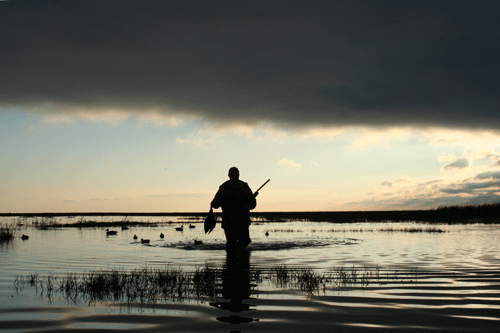
A steady stream of cold fronts has moved plenty of ducks down the Central Flyway, and here in Port O’Connor there are huge flights of birds that include redheads and pintails. Robert Sloan photo
The second split of the South Zone duck hunting season is open through Jan. 25, and based on what I’ve seen the past several days we definitely don’t have a shortage of birds on the bays, flats and marsh out of Port O’Connor. In fact, we’ve got redheads swarming like bats out of a cage; pintails seem to be plentiful, ditto that for scaup and bufflehead.
Duck blind poachers are worthless
Something that seems to be gaining in popularity here in Port O’Connor are the numbers of duck hunters that are too lazy to build their own blinds, and don’t hesitate to set up in just about any blind they can find. Last season I waded up to one of my primo duck hunting holes and found two grown men sitting in my blind. They politely informed me that they were on public water and had no intentions of leaving the comfort of my hard work. That’s about as low as a duck hunter can get. It’s akin to stealing in my way of thinking. Game wardens tell me that duck blinds built on public water are open for a first come first serve deal. However, they have also told me that it’s an unwritten rule that hunting in another person’s blind, without permission, is taboo.
Sky blasting is a waste of shotgun shells.
Aside from having no shortage of blind poachers there is also no shortage of sky blasters – a.k.a. duck hunters that will shoot at birds well past the range of steel shot. Shooting at ducks inside of 35 yards is fine and the way it’s supposed to be done. Conversely, shooting at ducks passing overhead at 50-plus yards is asinine, and does nothing but educate the birds.
The greatest thing a duck hunter can do is set up a good decoy spread, have a well camouflaged blind and be able to call birds within shotgun range for a sure kill. That’s the way it’s supposed to be done.
Calling all redheads
Just recently I had a duck hunter tell me that he didn’t use a call for diving ducks like redheads and scaup. His reason was that they don’t quack much. Even at that I can guarantee you that these ducks will definitely respond to calling, that is unless it sounds something like a predator call. The trick is to get their attention, then tone it down to nothing as they move toward the decoys. I’ll switch over from a duck call to a pintail whistle when the birds are just about within easy shotgun range.
Buffleheads by the thousands
One of the most abundant ducks on the middle Texas coast is a bufflehead, one that is often passed up by many duck hunters. Texas holds the record for the highest winter count of buffleheads of any state. The average number found in Texas, both on the coast and in the interior, has been recorded at 4,300. The daily limit is six.
A bufflehead is the smallest diving duck in North America. The name “bufflehead” is a direct reference to the duck’s large-headed appearance. The male is black and white with a large white patch extending from the eye to the back of the head. The female is dark brown above, paler below and has a small white cheek patch.
Nine times out of 10 buffleheads will fly low, as in 1 to 5 feet off the water, and will often swing into a spread of decoys when you least expect it.
Money Minnows for winter trout
Just recently guide Curtis Cash and I launched my 22-foot Mowdy and headed out to fish a flat adjacent to a channel. This particular area is about 5 feet deep and is a good spot to find trout just after a cold front moves through. We fished it on a low tide and used 3.5-inch Yum Money Minnows rigged on 1/8 ounce Bomber Shad-Head jigs. During two hours of fishing we boxed nine trout to 2-1/2 pounds. The best color combination was a yellow jig head on a pearl/chartreuse Money Minnow. The key was to slowly yo-yo the lure at about three feet deep. That water depth and that lure is a classic winter pattern for taking cold water specks.
Capt. Robert Sloan runs bay, jetty and duck hunting trips out of Port O’Connor. For details call 409-782-6796.
